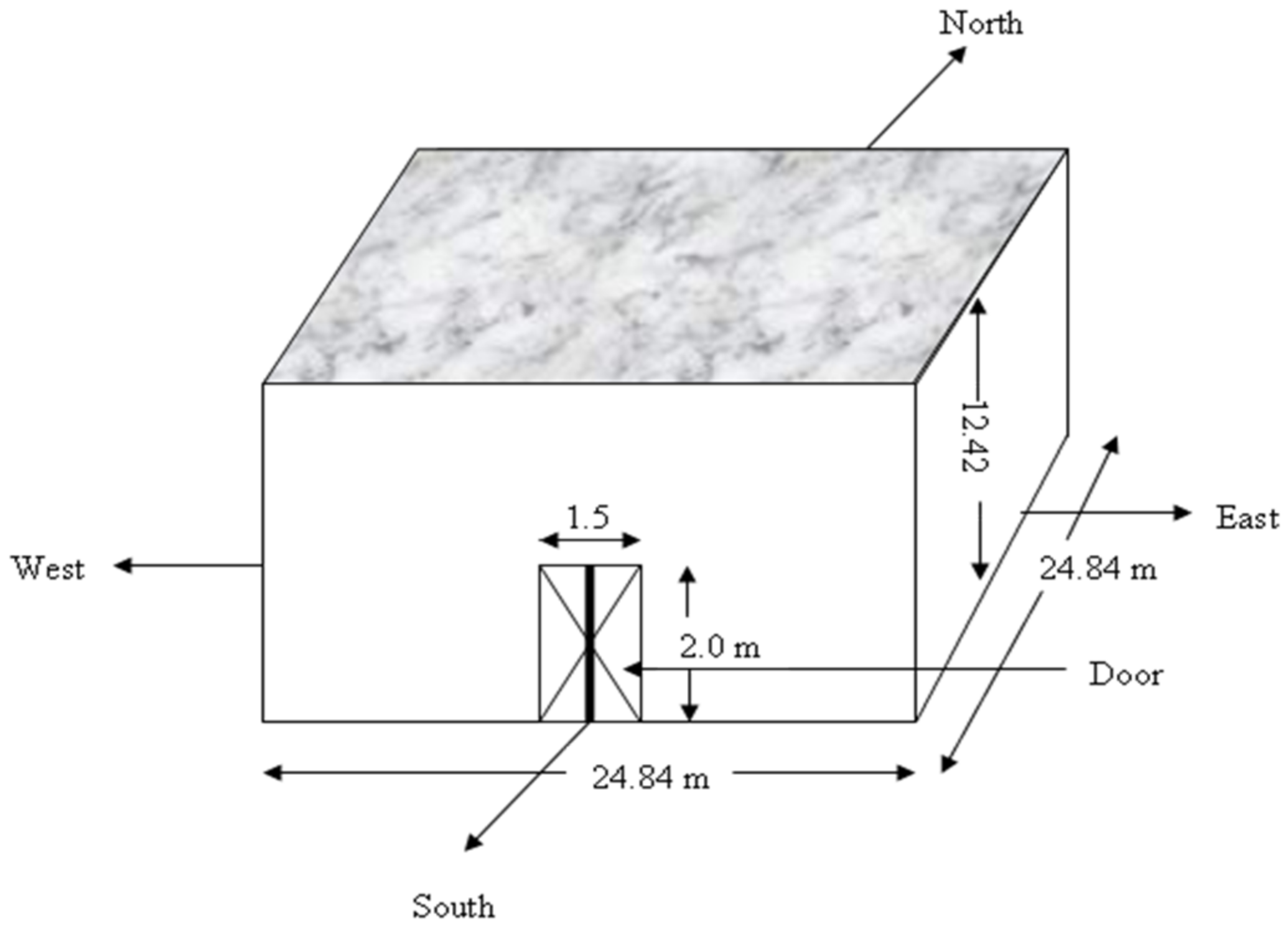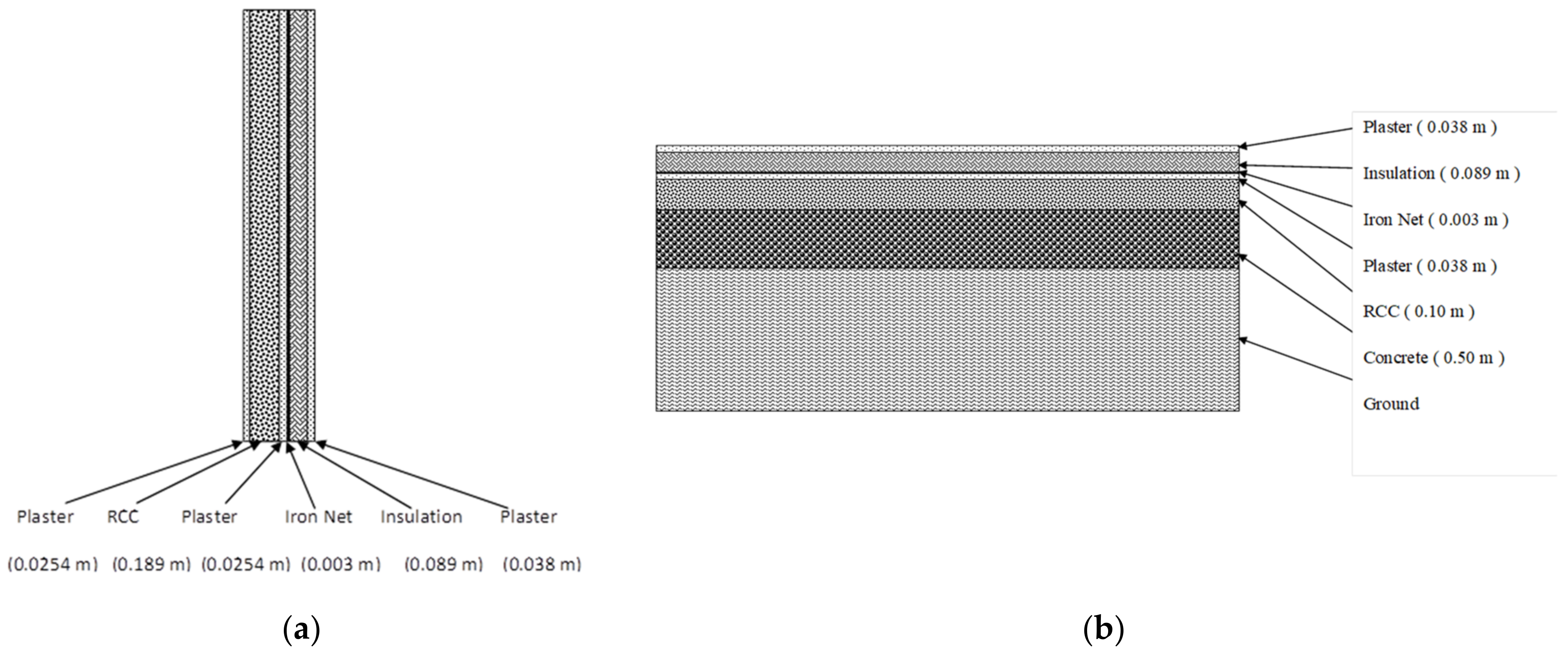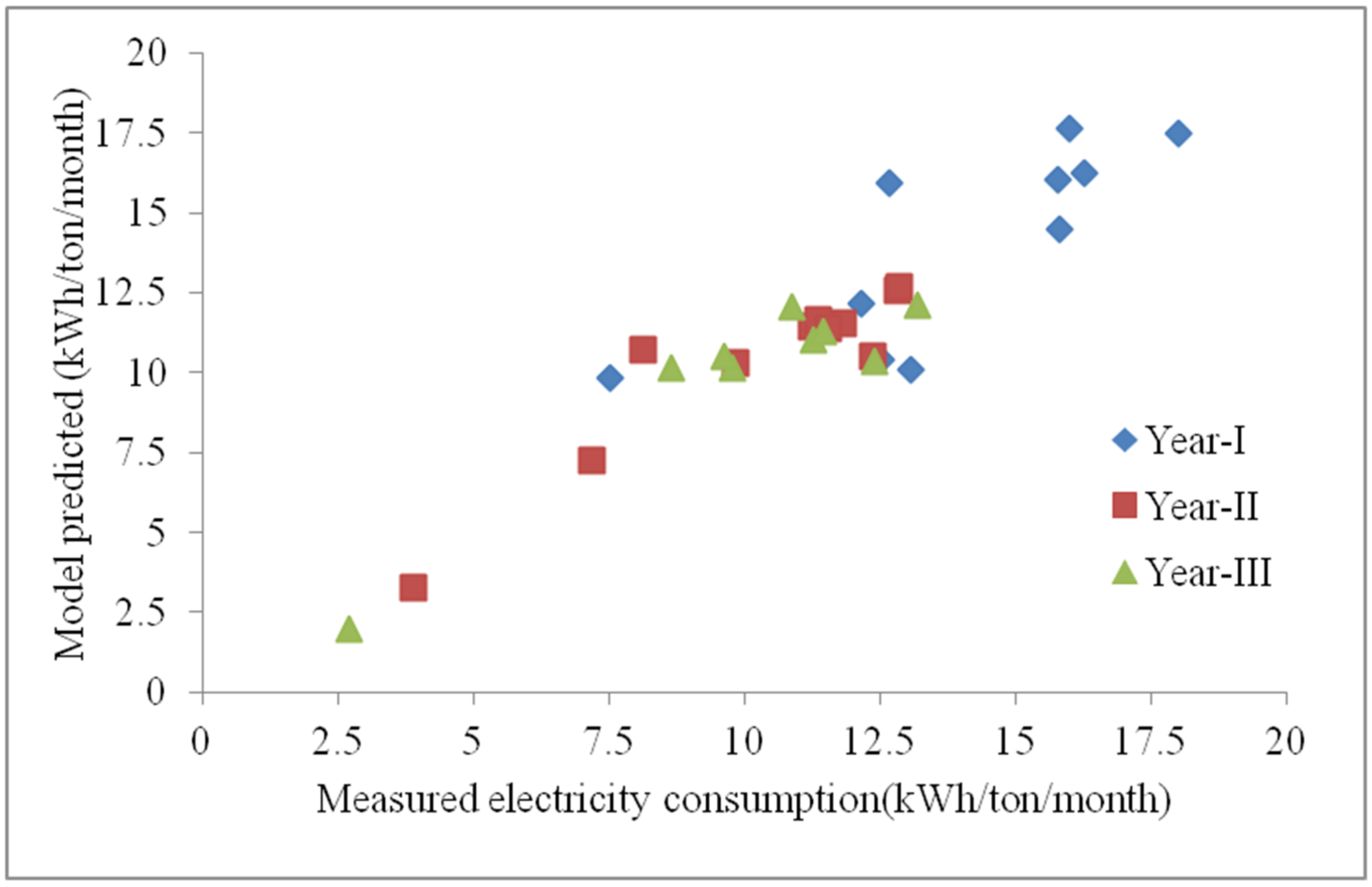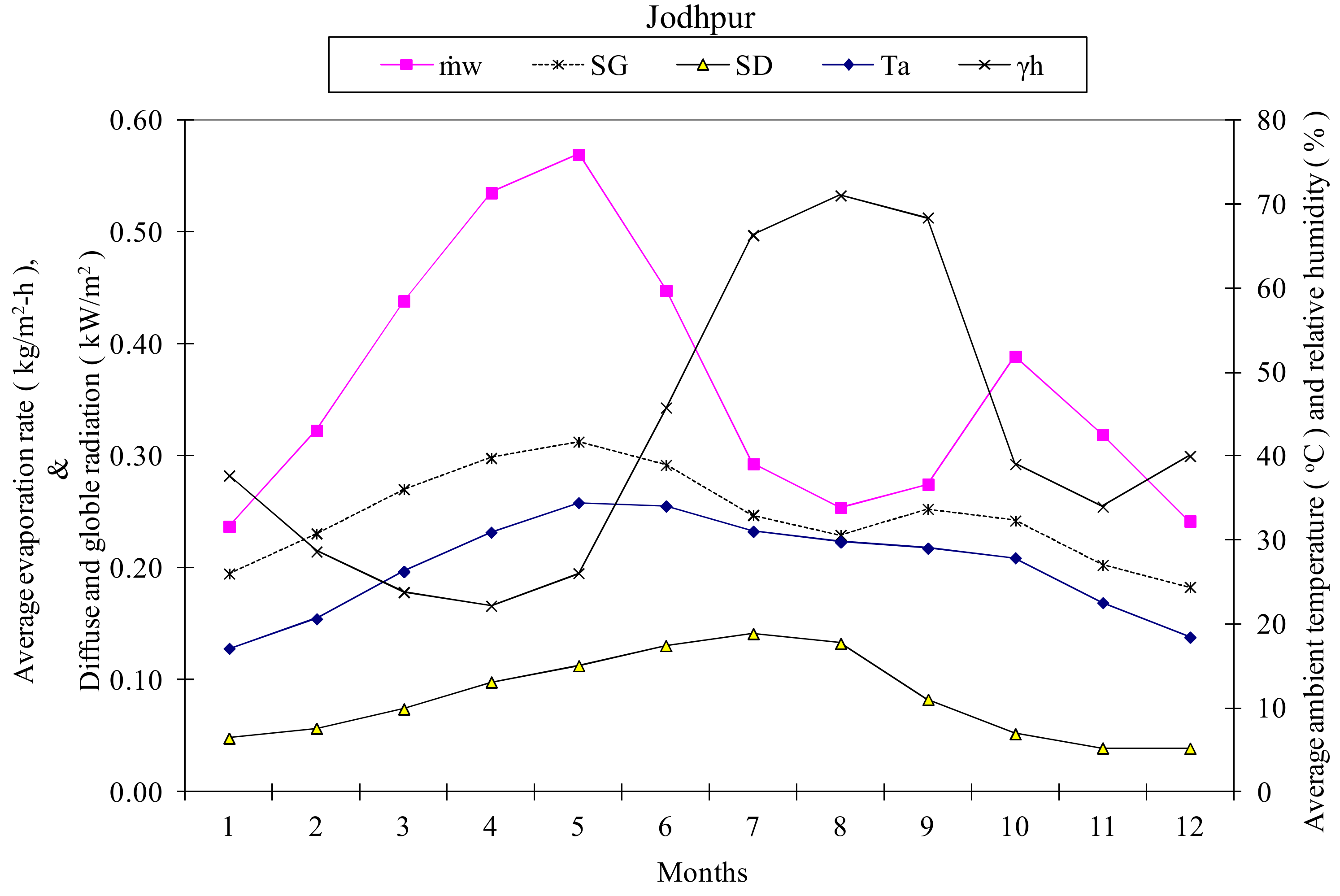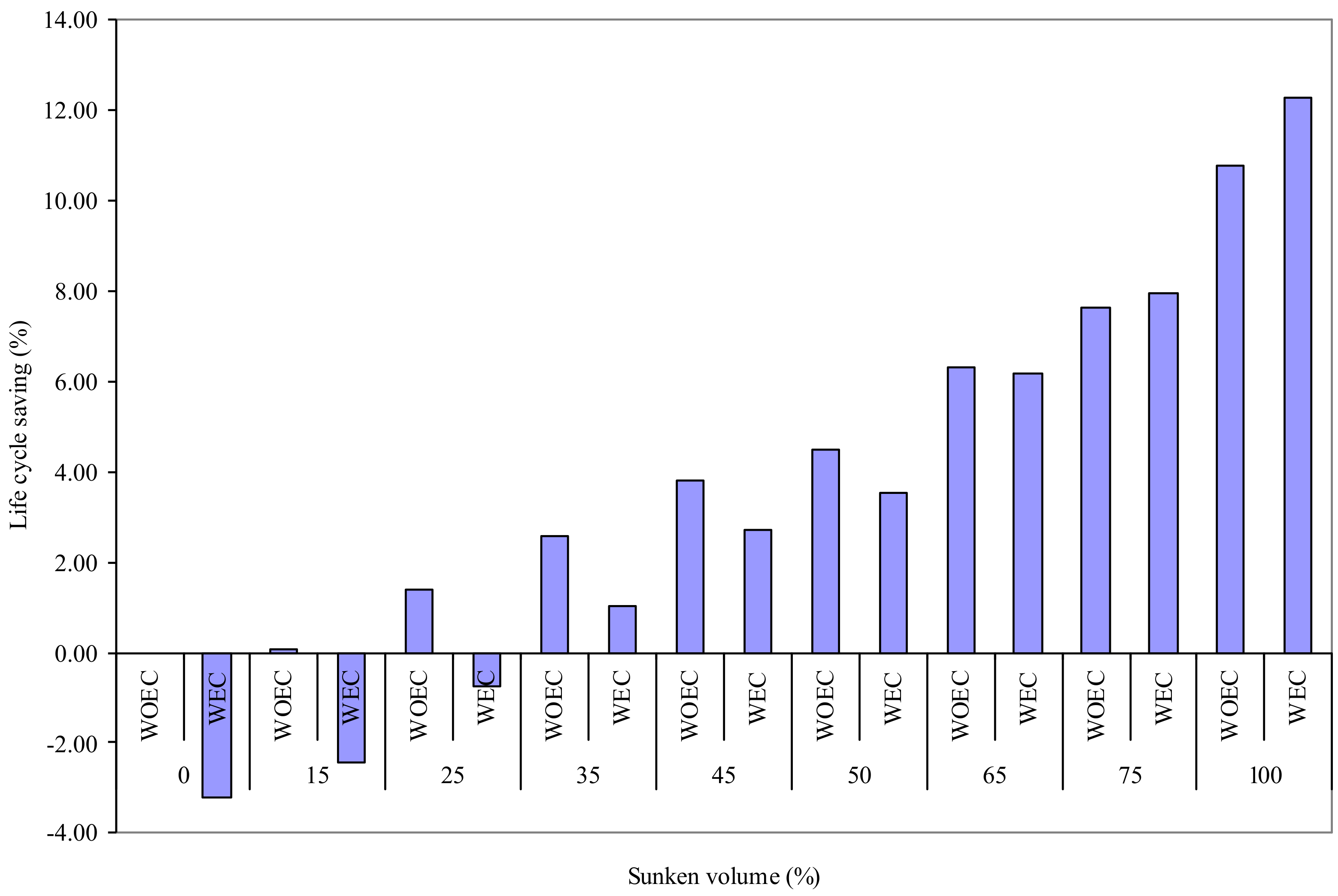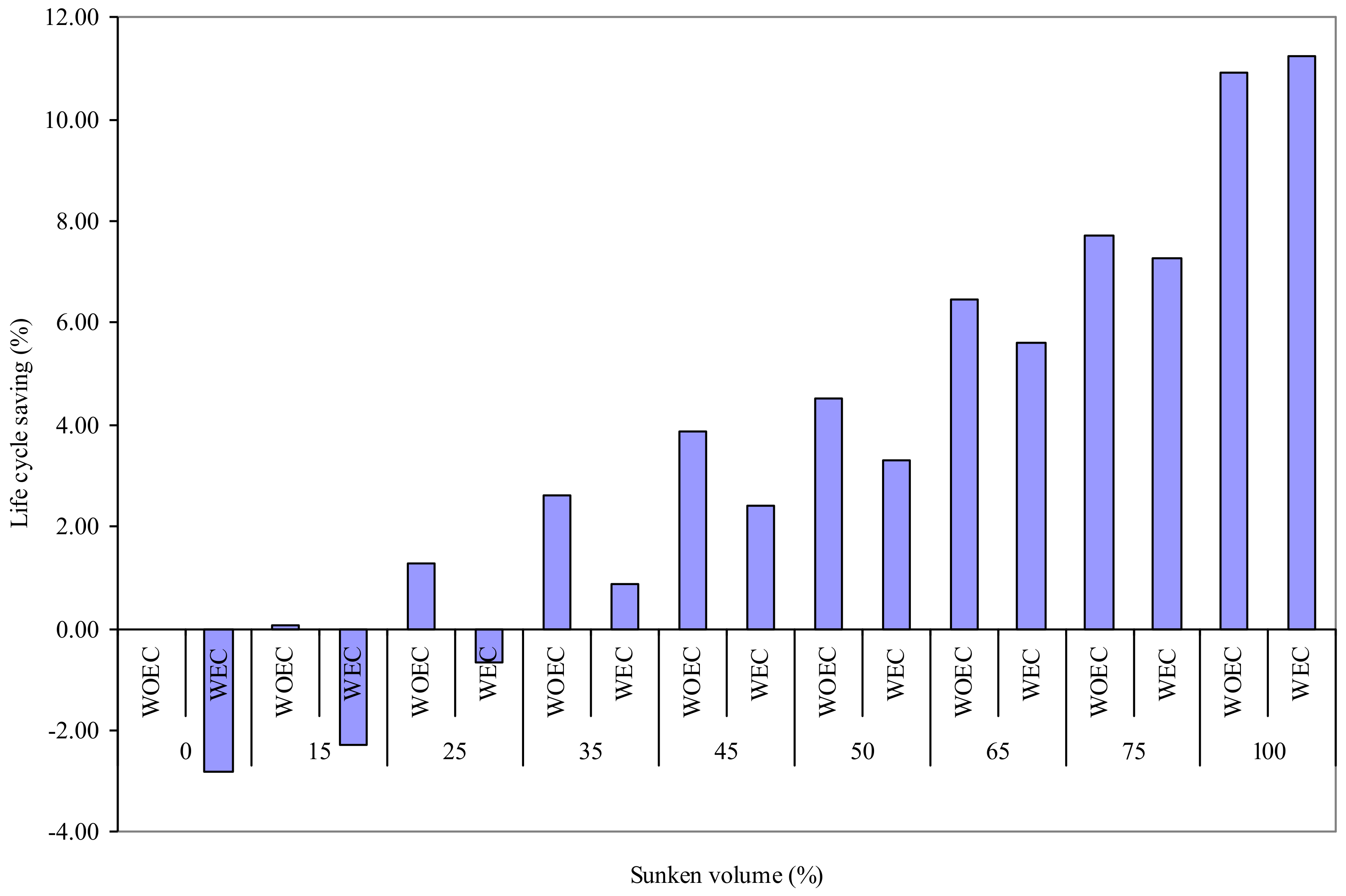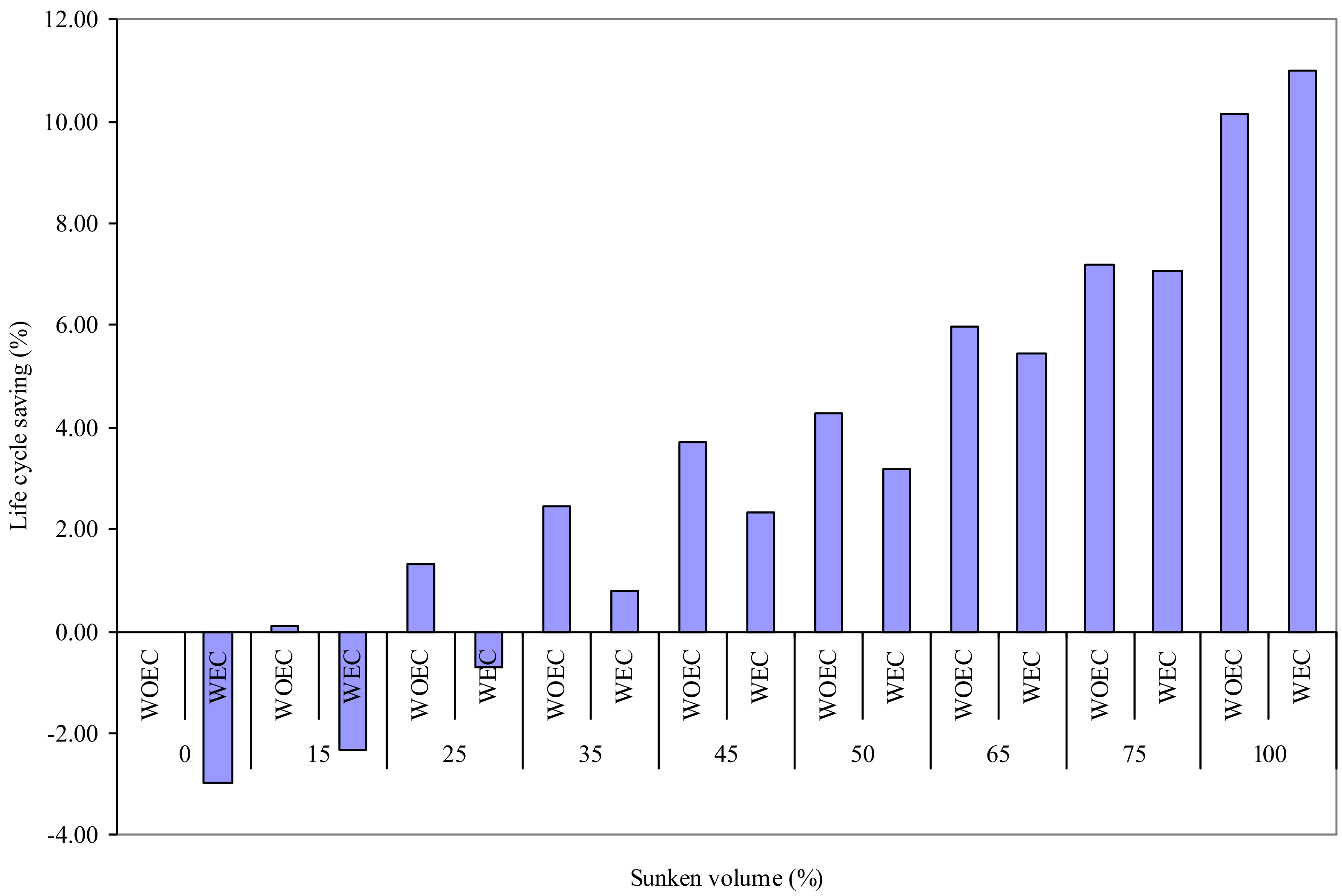1. Introduction
Cold storage is used for preserving fruits, vegetables, meat, fish, and other perishable materials. The preservation process in cold storage consumes a massive amount of energy that is mainly dependent on the grid or other fossil-fuel driven power generators (e.g., diesel generator). The specific energy consumption in Indian cold storage has been measured to be between 9 and 26 kWh/ton/year [
1]. Moreover, high post-harvest losses, especially in perishable products, due to unfavorable climatic conditions and increasing demand for fresh products throughout the year, have created a large demand for high-energy-consuming refrigerated cold storages [
2]. The operation of such processes increases the risk of global warming and climate change. Furthermore, the increasing cost of fuels due to the limited availability of fossil fuel also increases the risk of businesses’ economic viability. Therefore, it is vital to enhance the energy performance of cold storage buildings in order to reduce the adverse climatic effect of fossil fuels and improve the economic viability of the cold storage industry. The energy-intensive process in cold storage can be moderated significantly by integrating natural/passive cooling strategies into the storage building [
3]. The solar heat gain through the building envelope results in a larger refrigeration system and, eventually, higher energy consumption in cold storage. Generally, the storage temperature in a cold storage building is maintained at 4 °C or lower to keep perishable products (i.e., fruits, vegetables, milk products, meat and meat products, etc.) in fresh condition for longer periods. Despite the insulation of the building envelope, the direct exposure of the building surfaces to solar radiation and high ambient air temperatures lead to high heat gain. The results of a survey of cold storage buildings in India reveal that most of the cold storage facilities developed in the country are located above ground and exposed to direct sunlight. The direct sun exposure of the cold storage building not only has a negative impact on the overall energy consumption, but also increases the risk in the cold storage business. The use of the inherent cooling capacity of earth in the form of an earth-coupled building, and the considerable cooling potential of the roof evaporative cooling technique, have resulted in substantial energy savings in different buildings [
4,
5]. In some cases, the annual building energy consumption was reduced by 23–35% using only the earth-integrated building strategy [
6]. Moreover, the energy reduction potential varies significantly with climate, thermo-physical condition of the location, type of earth surface, and the integrated volume of the building [
7]. The reduction potential can also be improved by modifying the surrounding earth’s surface [
8,
9].
Furthermore, the roof in the building receives the greatest amount of solar radiation, which increases the cooling requirement, and thus needs to be addressed [
10]. The heat gain through the roof has been estimated to represent over 50% of the total heat gain through all of the surfaces of the building. This excessive heat gain through the roof occurs because a horizontal roof experiences the highest solar radiation. Roof cooling, particularly using the evaporative cooling technique, is deployed to mitigate the undesirable excessive heat gain through the roof [
11,
12,
13]. The roof evaporative cooling technique has been considered to be highly effective in lowering roof surface temperature and, eventually, reducing the heat gain through the roof.
Despite the substantial potential of earth coupling and roof evaporative cooling to minimize the energy consumption in conditioned buildings, it has hardly been explored for highly energy extensive cold storage buildings. Moreover, it is the authors’ understanding that the effect of varying the earth sunken depth, with and without roof evaporative cooling, on the economic feasibility of cold storage has not yet been explored in the literature.
Therefore, this study aimed to assess the techno-economic feasibility in terms of life cycle savings (LCSs) for cold storage buildings using the identified passive cooling concepts, i.e., earth integration and roof evaporative cooling, compared to above-ground buildings without the effect of any passive cooling concept. The use of such passive techniques individually produces considerable energy savings; however, a mix of two or more techniques may lead to much greater benefits. Therefore, the best combination of the passive techniques needs to be proposed to achieve the maximum energy savings. However, due to the large number of possible combinations of two or more passive concepts, it is a challenging task to identify the best suitable solution that requires the least investment and lowest operational cost, while reducing the adverse environmental effects. This study mainly focused on the assessment of the LCSs for different combinations of the two identified passive cooling strategies. For this purpose, thermal simulation was undertaken using a well-established and validated mathematical model, with the required modification based on the modified admittance method. The heat gain through the refrigerated building envelope and energy consumption were estimated using the model and validated against the energy consumption values measured from an existing cold storage building.
2. Description of the Storage Building
A single-room storage building, having a storage capacity of 2350 tons, was considered in this study. The dimensions of the cold storage room, which were previously optimized for minimum solar gain, were 24.1 m × 24.1 m × 12.0 m [
13] (
Figure 1), as also validated by the results of the field survey data [
1]. The storage room was assumed to be optimally oriented at 31, 20, and 25 degrees with respect to true south in Indore, Jodhpur, and Chennai, respectively [
14]. Openings (i.e., doors) are required in the building for loading/unloading and movements for maintenance and operational purposes. The thermal properties and operational frequency of the provided openings also play a role in overall heat transfer to the interior, and must be considered in the calculation procedure (as discussed in a
Section 3.1.1). For calculation purposes and to make the calculation easier, a single door opening of 3 m
2 was assumed to be placed in the north wall. The purpose of locating the door in the north side is to protect the entrance from direct sun exposure. In the actual case, the number of door openings may vary on a case-to-case basis and doors may be located in any vertical surface. The construction characteristics of the building components were considered based on the prevailing practices used for cold storage building construction in India, and were verified in the survey. The graphical illustration of the roof, walls and floor used in this study is shown in
Figure 2. The detail of the building construction characteristics identified during the survey were presented in our previous study [
1]. The thermo-physical properties of the construction materials are listed in
Table 1. The values of the heat transfer coefficients and other surface energy exchange parameters used in the calculation are given in
Table 2. The indoor temperature of the storage building was assumed to be 4 °C during the calculation, and was taken from the measurements from the existing cold storage building used for potato preservation [
15].
4. Validation of the Model
The accuracy of the predicted results for the heat transfer from different components of the model used in this study was verified previously by various researchers [
8,
9,
12,
17,
23], and thus can be trusted. However, to ensure the reliability of the estimated energy consumption values for the cold storage building using the model in the present study, the actual monthly energy consumption data from the existing cold storage building were used. One of the cold storage buildings was simulated by giving input values of the building construction characteristics, product storage pattern, internal storage temperature, and other parameters, which were measured during the survey [
1]. The details of the measured values can be seen in refs. [
1,
17]. Furthermore, the monthly energy consumption values were collected from the storage building for three years and were calculated using the developed model.
Figure 3 shows the comparative values of the simulated and actual measured energy consumption. The pattern indicates the predicted results are in an acceptable range. However, there may be some uncertainties and unpredictability in the predicted values due to various reasons. For example, we used a fixed stable indoor storage temperature, but in the actual case there may be variability in the storage temperature. Furthermore, a fixed infiltration rate was used in the simulation; however, the infiltration may vary from the fixed value. Therefore, the uncertainty and unpredictability were estimated in terms of statistical parameters such as the mean bias error (
MBE), root mean square error (
RMSE), and percent root mean square error (
PRMSE), as follows:
where
n is number of simulated values for each year, and
m and
p represent actual measured and predicted values, respectively. The estimated values of
MBE,
RMSE, and
PRMSE for the energy consumption per ton are listed in
Table 6.
The variation in the values for the energy consumption can be attributed to the effect of variation indoor temperature, rate of infiltration, and any other deviation in the actual operation of the cold storage building.
5. Results and Discussion
Peak and annual values of cooling loads for the storage building were estimated and compared for all of the selected alternatives. The impact of the sunken volume of the earth-coupled building and roof evaporative cooling on the cooling loads was assessed in the cold storage building for various sunken volumes of the building, without roof evaporative cooling (WOEC) and with roof evaporative cooling (WEC).
Figure 4a,b shows the percentage reduction in peak and annual cooling loads, without and with roof evaporative cooling for three Indian locations (i.e., Jodhpur, Delhi, and Chennai) in three different climates, i.e., hot and dry, composite, and warm–humid, respectively. The figures clearly indicate that there is no significant reduction in cooling loads for a small sunken volume (up to 20% sunken). The cooling loads reduce significantly and linearly with a sunken volume higher than the 20% in both cases, i.e., WEC and WOEC. Results also indicate that the integration of the roof evaporative cooling alone substantially reduces the cooling requirement in the storage building. The effect of roof evaporative cooling alone can be seen at the origin in the above figures, which indicates that the building is completely on-ground.
The roof evaporative cooling is comparatively less effective in the warm–humid climate than in the hot–dry and composite climates. The reason for the lower effectiveness of the technique is the reasonably lower water evaporation because of high humidity. Similarly, the evaporative cooling option reduces the cooling loads more effectively in hot–dry and composite climates due to the higher evaporation of the water. The evaporation rates of water with climatic parameters for the three considered locations are presented in
Figure 5,
Figure 6 and
Figure 7, respectively.
The reduction potentials in the peak cooling load in hot–dry, composite, and warm–humid climates were estimated to be approximately 4%, 3.5%, and 2% respectively (
Figure 4a). Moreover, the LCSs for varying sunken volumes of the storage building without and with roof evaporative cooling for the three climates are shown in
Figure 8,
Figure 9 and
Figure 10.
Figure 8,
Figure 9 and
Figure 10 clearly indicate that earth coupling of the building WOEC was not found to be effective for a sunken volume up to 15% in any of the climates; however, the LCS of the earth-integrated building increases linearly for sunken volumes higher than 15%. Similarly, earth coupling of the building WEC was found to be an effective option only if the sunken volume of the building is at least 35%. In other words, the positive values of LCS can be achieved by considering the earth-coupled building options WOEC and WEC only if the buildings are sunken by at least 25% and 35%, respectively. Moreover, LCS increases with sunken volume in both cases i.e., WOEC and WEC. However, the WEC option becomes effective in a hot–dry climate for sunken volumes greater than 50%. In the other two climates, the effective value of the minimum sunken volume for positive LCS is 65%. This variation occurs because of the decrease in the operational cost of the water pump with an increase in the sunken volume. Equation (11) clearly indicates that the energy consumption in the water pump is almost directly proportional to the head. The required head in the evaporative cooling decreases as the sunken volume increases and, eventually, energy consumption of the water pump decreases. The maximum savings that can be achieved through earth coupling of the building, WOEC and WEC, were estimated to be 9–11% in a hot–dry climate, and 9–10% in both warm–humid and composite climates.
6. Conclusions
Cold storage is one of the key elements in the cold chain infrastructure in India. The limited refrigerated storage facilities and their energy-extensive operation create continual challenges for minimizing post-harvest losses, particularly of perishable products. Moreover, due to the limited availability of fossil fuels, increasing fuel costs, and increasing temperatures, the operation of cold storage, and hence the refrigerated products, are expensive. Different passive cooling options have significant potential to reduce the heating load, the energy consumption in the refrigeration process, and, eventually, the operation costs, and thus improve the financial viability of cold storage facilities. In this study, the effect of earth integration and roof evaporative cooling on the energy consumption and life cycle savings in cold storage were assessed. Simulations were performed in three different climatic conditions in India. From the discussions of the simulation results, the following conclusions can be drawn:
The cooling loads in a cold storage building can be reduced significantly by considering the earth coupling of the building and the roof evaporative cooling, either individually or in mixed mode.
The energy saving potential increases with increasing the sunken depth; however, the magnitude of the saving potential is dependent on the climate.
The overall energy consumption in the cold storage can be reduced by 4%, 3.5%, and 2% in hot–dry, composite, and warm–humid climates, respectively, by using only the roof evaporative cooling.
In terms of LCS, the earth integration of the building without roof evaporative cooling was found to be effective only if the sunken volume is at least 25%; however, earth integration with roof evaporative cooling was found to be effective if the building is buried by at least 35%.
The minimum effective sunken volumes of the earth-coupled building, with and without roof evaporative cooling, are 65% for the warm–humid climate and 50% for both the composite and hot–dry climates.
The maximum LCSs achieved in the completely sunken building, WOEC and WEC, were estimated to be approximately 9–11% in both the hot–dry climate, and 9–10% in the warm–humid and composite climates.
The outcome of this study reveals that the integration of passive cooling strategies in cold storage buildings not only increases the economic feasibility of the cold storage operation, but also reduces the adverse climate change impact caused by the burning of fossil fuels. Furthermore, it will help in minimizing the post-harvest losses of perishable products, and increase the sustainability of the cold chain infrastructure and overall food security.
